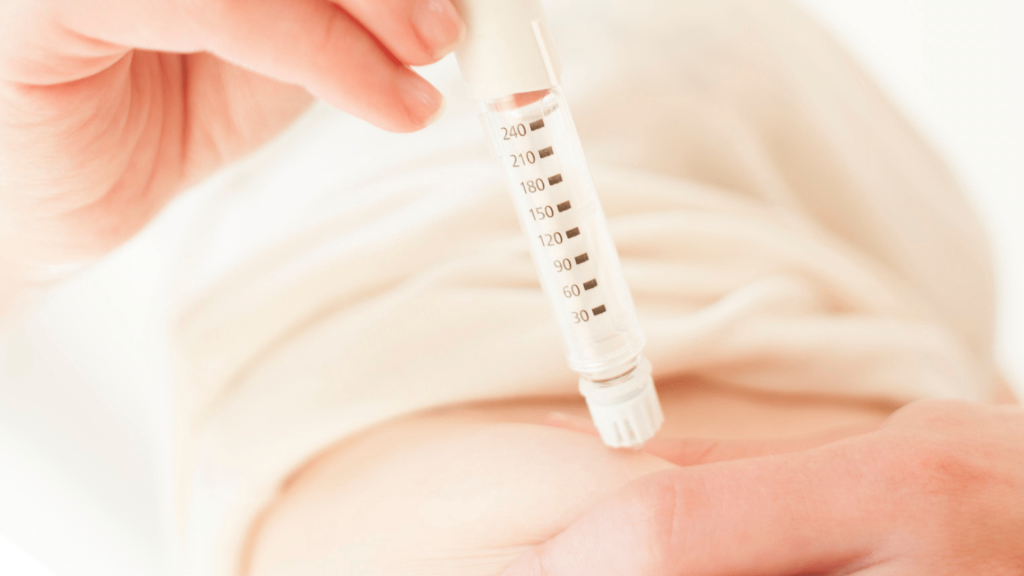What are the treatment options for diabetes?
The management of individuals with diabetes involves understanding the individual with diabetes, the type of diabetes, the presence of additional health conditions, their daily habits and goals of treatment. At Aspen Diabetes and Endocrine clinic, we understand that a more personalized and person-centered approach results in improved and better outcomes.
Management for Type 1 Diabetes includes:

1) Insulin therapy – There are several methods of insulin delivery – traditional methods of using syringes and vials have largely been replaced by insulin pens which are more convenient and portable. Needle sizes for injections are now much smaller, thinner and more comfortable. Insulin injections using syringe or pen injections usually require 2 different types of insulin:
a) Basal insulin (background insulin) – this is a long- or intermediate-acting insulin taken to keep blood glucose levels steady between meals and overnight
b) Bolus insulin (meal-time insulin) – this is a rapid- or short-acting insulin taken just before mealtimes to control blood glucose levels after meals.
Another method of insulin delivery is through an insulin pump, which is about the size of a pager. The pump delivers insulin through a thin plastic tube placed into the fatty layer under your skin. Using an insulin pump confers several benefits such as being able to deliver insulin more accurately, easier delivery of meal-time insulin, provide greater flexibility for different meals, exercise, and daily schedule, whilst also eliminating the unpredictability of intermediate- or long-acting insulin. More advanced insulin pumps are also integrated with continuous glucose monitoring systems with the ability to automatically adjust basal insulin delivery based on sensor glucose values with the user keying in the amount of carbohydrates for meal-time insulin delivery.

However, there are also some disadvantages to insulin pump therapy; usually relating to cost of the insulin pump and consumables, small risk of infection over the infusion site, and risk of high blood glucose and diabetic ketoacidosis should the pump system stop working correctly. Training for correct use of the insulin pump is required before starting on this method of insulin delivery.
At Aspen Diabetes and Endocrine Clinic, your specialist endocrinologist understands that being diagnosed with Type 1 Diabetes is a life-changing event and is here to support you in your journey to better glucose control and is well-versed with the latest technology advancements in diabetes.
2) Counting carbohydrates and healthy eating
Learning how to estimate and count the amount of carbohydrates in the food that you eat is an important aspect of Type 1 Diabetes management. By mastering this skill, you can give yourself the right amount of insulin needed for each meal. At Aspen Diabetes and Endocrine Clinic, a nutritious diet and healthy eating plan that is high in fibre and low in refined carbohydrates can be crafted together with you.
3) Monitoring blood glucose
It is recommended that you check your blood glucose level whenever you need to make a decision in your day-to-day management of Type 1 Diabetes. With this in mind, it is recommended to test your blood glucose when you wake up and before going to bed and before meals to help you decide your meal-time insulin dose. It is also recommended to test your blood glucose levels when you feel unwell, have symptoms of low blood glucose (hypoglycaemia), before critical tasks such as driving and before exercise. Your target blood glucose level before meals and at different times of the day need to be individualized with your doctor.
Methods of blood glucose testing include:
a) Finger-prick blood glucose tests using a blood glucose meter and test strips – this is the most common method of glucose monitoring and provides glucose data at specific time points. Some blood glucose meters are now connected with mobile health applications to store your diabetes data which removes the need for manual recording of blood glucose levels.
b) Continuous glucose monitoring (CGM) – CGM systems measure glucose in the interstitial fluid as frequently as every 5-15 minutes. This system uses a sensor placed over the abdomen or upper arm to provide a continuous glucose tracing to your smartphone or a connected wireless handheld device, for a detailed look at glucose levels. Advantages of such a system is the convenient ability to test blood glucose levels without pricking your finger, greater visibility of glucose trends and data at different time points which allow a greater understanding of how food, physical activity, medications, stress and sleep impact on blood glucose levels and insight into overnight glucose levels which may otherwise be unknown. Another valuable aspect of CGM is that alarms can be set to alert the user to low and high blood glucose levels. Data can also be shared with a caregiver and/or healthcare provider.

At Aspen Diabetes and Endocrine clinic, our specialist and team embrace the use of diabetes technology to make living with diabetes easier. Our team has the experience and expertise in interpreting glucose patterns and data, and advising you on how best to adjust your medications or modify your lifestyle to achieve a healthier you.
4) Exercising regularly and keeping a healthy weight
There are vast benefits to exercise. Exercise helps to control weight, lower blood pressure, lower harmful LDL-cholesterol and triglycerides, raise healthy HDL cholesterol, strengthen muscles and bones, improves mood and general well-being. Exercise for people with diabetes helps to lower blood glucose levels and improves the body’s sensitivity to insulin. For people with diabetes, the best time to exercise is after eating when blood glucose level is likely to be higher.

It is recommended that you engage in moderate-intensity (able to talk in phrases or short sentences but unable to sing) aerobic physical activity for at least 150 minutes per week. Additional resistance exercises (strength training) on at least 2 days a week help to develop and maintain muscle strength. For those above 50 years of age, strength and functional balance training is recommended at least 3 days a week. A variety of different activities (e.g. swimming, jogging or walking, skipping or playing a racquet sport) helps to engage different muscle groups.
Examples of aerobic and muscle strengthening exercises:
|
Aerobic |
Multicomponent (mixed) |
Muscle strengthening and Balance |
|
Jogging Brisk walking Dance classes Zumba Skipping |
Cycling Swimming Racquet sports Circuit training |
Yoga Pilates Tai Chi Weight training |
5) Stress Management and Sleep
Stress is a natural human response usually because of a challenging situation, which results in a state of worry or mental tension. Everyone experiences stress at different times of their lives, and it is the way we respond to stress that makes a big difference to our general health and well-being. A small amount of stress drives and motivates us, providing us with the energy to perform at our best, for example, before an exam or a competition. However, chronic stress or high levels of stress can negatively affect our health and lead to poor physical and mental well-being. Stress can lead to poor sleep and poor lifestyle choices such as over-indulging in foods high in refined carbohydrates and fat or binge-watching TV. For people with diabetes, stress can also lead to higher blood glucose levels.
For people with diabetes, stress can also be a result of the extra vigilance needed for the management of diabetes, the constant decision on food choices, monitoring and controlling blood glucose levels. This can lead to increased distress and anxiety.

Sleep and physical health are closely connected. Having insufficient sleep disrupts the body’s natural circadian rhythm (our body’s internal clock). Chronic sleep deprivation leads to an increase in the risk of obesity, high blood pressure, diabetes, cardiovascular disease and cognitive impairment.
As such, both stress management and sufficient sleep are necessary for overall health and mental well-being. Strategies to cope better with stress include understanding that stress is a normal part of life, being more aware of the signs of stress and having healthy strategies to cope with stress better such as through exercise and having sufficient time for rest and relaxation. Having a plan to cope with stress will help you through challenging and stressful moments.
